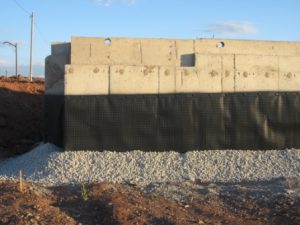By definition, dampproofing (or damp-proofing) means “to make resistant to dampness or the effects of dampness”. The term “waterproof”, on the other hand, means “to make impervious to water”. For homeowners in need of basement waterproofing, the two terms tend to be used interchangeably.
From a waterproofing contractor point of view, differentiating between the two terms is moot because the objective of keeping a basement dry, or waterproofing it, is to prevent water, or moisture, from entering the basement. There are technical differences between waterproofing and dampproofing for basements; we discuss typical dampproofing applications towards the end of this article.
In this article we cover the following topics:
Basement Dampness
Dealing With a Damp Basement
Dampproofing in Building Construction
Basement Dampness
When a homeowner concludes that their basement is too damp, ie., they can sense high humidity as the enter their basement, they typically assume that some dampproofing measures are required. This assumption is technically correct; however, we should point out that resolving basement dampness issues has a degree of complexity associated because determining the cause(s) accurately can be very difficult.
With respect to basement damp-proofing there are actually 5 common causes of basement dampness:
- Moisture from the soil surrounding the foundation is wicking through the foundation walls causing the basement to become damp;
- The foundation is leaking, thereby introducing water into the basement which is increasing the moisture content of the ambient air;
- Water is penetrating the building envelope and is making its way into the basement, thus increasing the relative humidity of the air in the basement;
- Condensation in the cold cellar; and
- An unfinished crawlspace (typically with a soil floor) is permitting a significant amount of moisture to increase the humidity of the basement ambient air.
Dealing With a Damp Basement
Any discussion that deals with the question of how to fix a damp basement must take into account the cause(s) of the basement dampness. If moisture from the soil around the foundation and beneath the basement floor is the cause of the high basement humidity (water is wicking through the concrete) then the most economical and practical solution is the use of a dehumidifier (make sure you close the door to the main level). In general, the relative humidity (percentage of moisture in the ambient air) should be no greater than 35% in the winter and no greater than 50% in the summer.
Note: When we mention “wicking” we are referring to moisture being absorbed by the concrete, travelling through the foundation wall(s), and evaporating in the basement. This phenomenon should not be confused with “seepage” which is typically associated with the presence of water on the basement floor.
When a foundation is leaking and introducing groundwater into a basement, a dehumidifier can help significantly; however, it will not solve the problem. When it has been confirmed that a basement is leaking, waterproofing is the appropriate solution to the problem. If water is entering the basement by penetrating the building envelope above the basement, then the solution is to prevent this penetration from occuring (this normally involves caulking of areas through which water is penetrating the building envelope).
When an unfinished crawlspace is the source of excessive basement humidity, the industry standard way of controlling basement humidity is crawlspace encapsulation (basically covering the exposed soil with a sheet of plastic which acts as a vapour barrier).
Dampproofing in Building Construction
Current residential construction practices in Ontario include dampproofing measures, the installation of an air-gap membrane, or foundation wrap, around a foundation. This membrane prevents the wet soil around the home from being in constant contact with the foundation walls. It should also be noted that, compliance with the Ontario building code requires foundations to be sprayed with a coating (usually tar). While this coating is not ideal for long lasting basement waterproofing, the tar does a good job of dampproofing a foundation. This practice of dampproofing has been in use since the 1950s.
In commercial construction it is common practice to dampproof frost walls which are essentially 4′ high foundations supporting new structures. When frost walls are built there is no basement. The dampproofing is done in order to protect the naturally porous concrete from wicking moisture and deteriorating over time.
Rubber waterproof coating applied
Foundation wrap installed over waterproof coating
